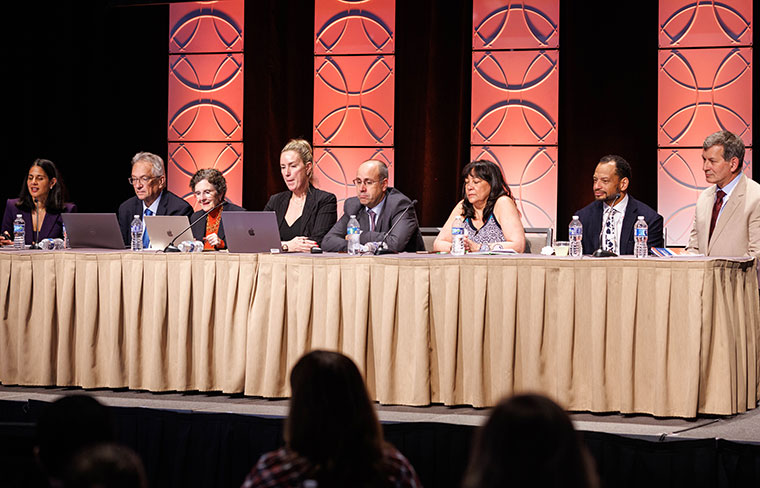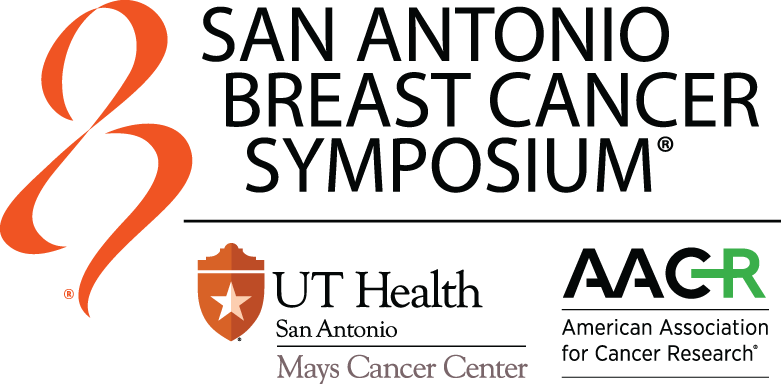
The final session of the 2023 San Antonio Breast Cancer Symposium® wrapped up four days of data presentations with highlights and practical insight for putting the information into practice.

Sara Tolaney, MD, MPH, Dana-Farber Cancer Institute and Harvard Medical School, moderated a panel of experts discussing ways they expect clinical trial results and other information presented at the 2023 SABCS® to affect clinical practice during View from the Trenches: What to do Monday Morning.
The panel included:
- William E. Barlow, PhD, Fred Hutchinson Cancer Institute
- Javier Cortes Castan, MD, PhD, International Breast Cancer Center
- Lesley K. Glenn, BS, Project Life
- Heather McArthur, MD, MPH, Simmons Cancer Center and The University of Texas Southwestern
- Joyce O’Shaughnessy, MD, Baylor University Medical Center
- Alastair M. Thompson, MD, Baylor College of Medicine
- Richard Zellars, MD, MBA, Indiana University School of Medicine
First line therapy for metastatic ER+ breast cancer
Multiple phase 3 trials explored CDK4/6 inhibitors for advanced and metastatic ER+ breast cancer, including the MONARCH (abemaciclib), PALOMA (palbociclib), and MONALEESA (ribociclib) trials. Dr. Tolaney noted that all three agents have shown consistent improvements in progression-free survival of about 50% in the first line setting.
MONARCH-3 was marginally underpowered to produce a significant overall survival (OS) outcome, Dr. Barlow noted.
In terms of practice, Dr. O’Shaughnessy said, the delta on survival is large, at 13.5 months. And the study met the primary endpoint of progression-free survival (PFS), which was the priority. She said she would continue to use abemaciclib in the first line setting for patients that have more virulent disease.
The PARSIFAL trial compared different endocrine backbones in combination with CDK4/6 inhibition: palbociclib + fulvestrant vs. palbociclib + letrozole. The study did not demonstrate either superiority or noninferiority in PFS or OS.
Dr. McArthur said it would not change her practice, but it did reassure her about the historical data that shows that endocrine therapy is consistently effective as a backbone for CDK4/6 inhibition.



The INAVO120 trial explored metastatic HR+ breast cancer with early relapse and PIK3CA mutations. The trial compared inavolisib, a highly selective inhibitor and degrader of mutant PIK3CA, + palbociclib + fulvestrant vs. placebo + palbociclib + fulvestrant. The inavolisib arm showed a statistically significant improvement in progression-free survival over the placebo arm.
Adverse event rates were similar, but the inavolisib arm had significantly more infections, hyperglycemia, diarrhea, nausea, and rash.
Dr. Cortes Castan noted that clinicians currently do not use genomic testing at third line treatment because these do not change treatment for patients. But once inavolisib is approved, he said, that will change.
Adjuvant CDK4/6 inhibition
MonarchE compared abemaciclib + endocrine therapy to endocrine therapy alone in a population with HR+, HER2-, node-positive, high risk early breast cancer (EBC). NATALEE compared ribociclib + a nonsteroidal aromatase inhibitor (NSAI), either letrozole or anastrozole + goserelin in men and premenopausal women vs. NSAI alone in patients in HR+, HER2 EBC with Stage II or III disease.
While ribociclib is not approved for intermediate risk patients in Europe and not reimbursed, Dr. Cortes Castan said he would consider using it if given the opportunity.
Toxicity is an important issue, particularly with abemaciclib.
Glenn said she would want a care team to break down the side effects for patients, and she would want plenty of follow-up from nurses by phone. From her perspective, she said patients might be more willing to stay on the course of treatment knowing there was a genuine interest in helping them finish.
Immunotherapy in early-stage, high-risk ER+ disease
KEYNOTE-756 and CheckMate-7FL explored the role of immunotherapy in early-stage, high-risk ER+ breast cancer.
KEYNOTE-756 compared neoadjuvant pembrolizumab + paclitaxel, then pembrolizumab, + doxo/epirubicin + cyclophosphamide, followed by surgery, then adjuvant pembrolizumab + endocrine therapy to the same regimen without pembrolizumab. Adjuvant radiotherapy was added to both arms as indicated. Patients had locally confirmed invasive ductal breast carcinoma, T1c-T4, N0-N2, centrally confirmed ER+/HER2- grade 3 disease and were treatment naïve.
The CheckMate-7FL trial compared adjuvant nivolumab + paclitaxel followed by nivolumab + anthracycline chemotherapy followed by surgery and adjuvant nivolumab + investigator’s choice of endocrine therapy vs. the same regimen without nivolumab. Patients had newly diagnosed ER+/HER2- breast, T1c-T4, N0-N2 disease with tissue available for biomarker assessment.
Dr. McArthur noted that she was involved in both the KEYNOTE-756 and CheckMate-7FL studies and finds the results exciting, but she added that she was anticipating event-free survival data to inform further decision-making.
Locoregional management
The SENOMAC trial compared standard of care for patients with a positive sentinel lymph node (SLN), complete axillary dissection, vs. no axillary dissection.
When comparing those with and without complete axillary dissection, there was no difference in recurrence-free survival at five years.
Dr. Thompson said the data confirmed the need for less surgery in certain conditions and being more selective when going into the axilla. He noted the information complements the AMAROS trial, which demonstrated that radiation is just as effective as more extensive surgery.
NSABP B-51 compared the effect of regional nodal irradiation (RNI) vs. no RNI in patients with negative axillary nodes following neoadjuvant chemotherapy followed by mastectomy or breast conserving surgery (BCS). BCS patients in both arms received breast radiotherapy. Mastectomy patients in the RNI arm also received chest wall radiotherapy while mastectomy patients in the no RNI arm did not receive chest wall radiotherapy.
The invasive breast cancer recurrence-free interval (IBCRFI) was the same in both groups.
Dr. Zellars said the data makes a strong argument against nodal irradiation for those who convert to negative. He also noted that there is retrospective data that supports this approach.
HER2+ disease
The KATHERINE study compared the antibody-drug conjugate (ADC) ado-trastuzumab emtansine (T-DM1) to trastuzumab in the adjuvant setting for HER2+ women who had neoadjuvant therapy with residual invasive tumor and were randomized within 12 weeks following surgery. Adjuvant radiation and endocrine therapy were allowed per protocol and local guidelines. Switching to trastuzumab was allowed if T-DM1 was discontinued due to adverse events. T-DM1 significantly improved overall survival over trastuzumab after 8.4 years median follow-up.
Dr. Tolaney wondered if there are any patients with residual HER2+ who should not get T-DM1; Dr. Cortes Castan said there were not. He also questioned arguing against using PFS in metastatic disease for drug approvals, saying that thousands of patients’ lives were saved by using T-DM1 before survival data was available.
HER2CLIMB-02 compared tucatinib (TUC) + T-DM1 vs. placebo + T-DM1 in HER2+ patients with locally advanced or metastatic disease with progression after trastuzumab and taxane in any setting.
A planned interim analysis at median follow-up found that adding TUC increased PFS, and patients with brain metastases benefited. OS data was immature.
An earlier trial, HER2CLIMB, found that adding tucatinib to trastuzumab + capecitabine significantly improved PFS and OS, including in patients with brain metastases.
Dr. O’Shaughnessy said the survival advantage in the overall population as well as in the brain met population is in HER2CLIMB. The data are stronger for the TCT regimen because there is no survival data yet in HER2CLIMB-02, and she planned to stick with the TCT regimen.





